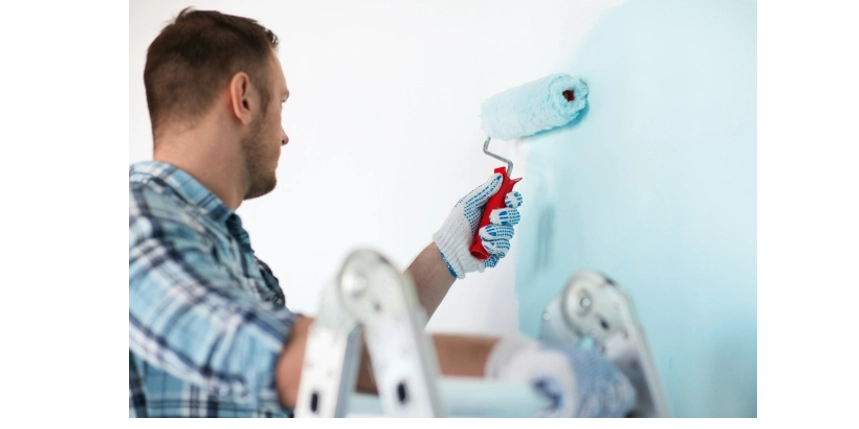
Five Star Painting shares essential tips for safe indoor painting.
|
Painting is a chore that nearly everyone will do at some point in their lives. The equipment and materials can be bought in home improvement and hardware stores across the country and globe, but how many people stop to think whether painting, especially indoors, is safe?
Paint, even water-based types, is a product that will produce fumes, which is usually the first thing people become aware of when they begin an indoor painting project. However, many people overlook or minimize the safety hazard associated with paint fumes. In this article we’ll explain some of things you should take into consideration when painting indoors so you can do it safely.
Indoor Painting Precautions
Below are a few things to consider when painting indoors. Although this is not a ranked list, when painting indoors you should consider proper ventilation very high on the list of safety measures. However, all of these things should be taken into consideration whenever you begin a paint project.
Proper Ventilation
Proper ventilation is extremely important when painting indoors. Paint is made from chemicals that produce fumes which are dangerous for people, especially children, to inhale for prolonged periods of time. When possible, open windows and doors to improve air flow. If you cannot ensure proper ventilation, make sure you take breaks frequently to minimize the effects of the fumes. If you feel dizzy or become light headed, leave the room and get some fresh air. For items like furniture, paint them outside where ventilation is not an issue.
There are some other factors to consider when painting indoors. Does the room you’re painting in have a ceiling fan? If so, turn it on to improve air circulation. If there isn’t a ceiling fan installed, try using a standalone fan (put it on oscillate) to help with circulation.
If you are painting during the colder months, and have to open a window or two for ventilation, use a portable heater to keep the room from getting too cold.
Even good ventilation will not fully remove the potential threat associated with paint fume exposure, so make sure you step away from painting from time to time. This will help ensure you are getting fresh air in your lungs.
If ventilation is difficult, or not an option, use a water-based paint that is low in VOCs to minimize the effects of paint fumes. As mentioned, when working in a poorly ventilated room, take frequent breaks to reduce prolonged exposure.
Protective Equipment
Because paint has a chemically base, fumes aren’t the only negative byproduct. Protective gloves and glasses (or goggles) should be worn to avoid irritation caused by accidental or inadvertent contact with skin or eyes. If does come in contact with your eyes, flush immediately with water.
In addition to wearing gloves and glasses, a protective face mask can be worn to help mitigate inhaling the fumes produced by your paint. These protective items can help reduce the risk of injury caused by the chemicals in paint. Once your paint project is complete, be sure to dispose of them properly so chemicals from paint residue doesn’t linger in your house.
Finally, consider using a respirator mask (available at most paint and home improvement stores) if paint for an extended period of time. The added layers of filtration in a respiratory mask will provide addition protection (something a standard N95 mask can’t provide).
Other Aspects to Consider
Painting might mean a quick touch up or a full room refresh, either way there are factors to consider.
For example, if you are using a ladder, make sure you use it safely and according to the manufacture guidelines (which rungs are safe to use and which ones are not).
Make sure any drop clothes or vinyl sheets used to cover flooring is stable enough if used under a ladder to avoid a potential slip and fall accident. Even beyond ladder safety, many people use vinyl or cloth to cover their floor and catch any paint. Be careful when walking or carry item over floor covering to minimize the risk of an accident.
Cleaning Up and Ending Your Project
Even though you might have just wrapped up your painting, this doesn’t mean you still don’t have some safety procedures to follow.
Let’s start with paint disposal. Disposal regulation for hazardous chemical varies depending on where you live, so check your local guidelines to confirm. Also, different paints have different disposal restrictions, with disposal of oil-based pants being more restricted than water-based. Most oil-based paints need to be disposed of at a designated chemical site in your area to ensure safe disposal. Latex paints can be handled differently, though, as they are water-based. One helpful tip is to use either a paint hardener or even cat litter to solidify the paint and make it less likely to spill or cause a mess in the trash.
However, just because you don’t need the paint anymore doesn’t mean you have to immediately throw it away. Some charities, like Habitat for Humanity, accept used paint to donate to families that need to update their homes but might not have budget room.
Other materials, such as brushes and pans, should also be disposed of according to the base of the paint used (oil vs. water) to ensure that safety is the focus. You’ll want to make sure a room has an appropriate amount of time to dry and air out before it is safe to sleep in. Although you won’t need to wait days, you should make sure you give it at least a few hours.
Let’s Get to Work
Once you’ve taken all the appropriate steps to ensure that you’re painting safely indoors, the only thing left to do is get to painting. To ensure the highest level of safety and quality, we recommend starting with either Sherwin-Williams or Behr products. Both are high-quality paints used and recommended by professionals like, Five Start painting. And if you have questions or need help with your next painting project, give us a call at (888) 261-3633, request an estimate or schedule an appointment online.


